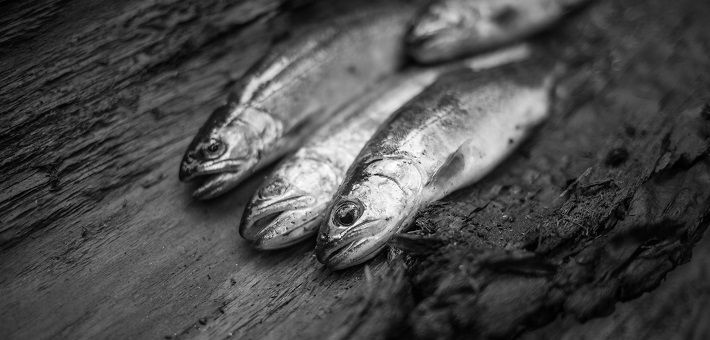Commentary on John 6:51-58
In this section of the Bread Discourse, the dispute “chews” on Jesus’ flesh. Was this the narrator’s plan all along?
- “I am the bread of life, whoever comes to me will never be hungry, and whoever believes in me will never be thirsty” (verse 35);
- “one may eat of it and not die. I am the living bread” (verses 50-51);
- “… the bread that I will give for the life of the world is my flesh” (verse 51b);
- “whoever eats me will live” (verse 57).
Over the course of this chapter, the narrator has moved steadily from metaphor to eucharistic realism.
This section of discourse begins with religious leadership erupting with cutting sarcasm (pun intended): “How can this man give us his flesh [sárka] to eat?” (verse 52). In answer, Jesus reprises a negative version of verse 35: “If you do not eat the flesh of the Son of the Human Being and drink his blood, you have no life in you.” Verse 54 says the same thing, but positively, and in the first person rather than the third: “Those who eat my flesh and drink my blood have eternal life.” The narrator has shifted from the receptive verbs of “seeing” and “believing” (verse 40) to “eating and drinking” leading to eternal life (verse 54). Manna does not give eternal life like the bread that “comes down from heaven” (verse 58).1
In chapter six, John’s narrator uses multiple verbs to convey the act of eating. Jesus uses trogein in verses 54, 56, 57, and 58b. The NRSV makes no distinction between the verbs, rendering all as “to eat.” However, the larger context may make a case for a more textured translation. First, in the leadership quarrel in verse 52 they use the perhaps less earthy version of to eat, phagein. Jesus’ verb choice is arguably more offensive, leaving his metaphorical flesh stuck in their teeth—or a recollection of John’s prologue introducing the incarnation: The Word became flesh because God so loves the world.
Second, the narrator carefully composed each of the elements of this chapter, knitting them together into a cohesive whole. Would it be surprising if the narrator were revisiting in this eucharistic moment the realism of the multiplication of barley loaves and dried fish? These are not highly processed foods that you can quickly eat, almost without chewing. Jesus is the opposite of commodified food. Chew, gnaw, nibble, munch, eat (audibly, like animals)—all of these suggest possible renderings of this verb.
Raymond E. Brown uses “to feed” for trogein because it emphasizes the realism of the Johannine account of the eucharistic meal.2 It also functions as both verb and noun: daily feed for the sheep and animals feeding. Jesus’ flesh and blood is the believer’s daily bread, the believer’s daily feed. It seems to offer semantic range for the way, by feeding, the believer “remains” or “abides” in Jesus and Jesus in the believer (verse 56).
The Fourth Gospel is sometimes called the Gospel of Life. For good reason, according to Brown: “life” occurs 36 times in the Gospel of John and 16 times in the Synoptics. “Life” and “live” occur 17 times in the NRSV of the Bread Discourse. For John, eternal life is not something that God gives to us in the “next” life. Rather, it is something we experience in this life, though it is not determined by the natural life. Brown distinguishes the “natural life” which God gives when God breathes the Spirit into the human being and the Spirit that Jesus breathes onto the disciples in the locked upper room. The narrator views the coming of eternal life through the incarnation, namely the real life of Jesus. In that sense, those who trust in Jesus have already passed from death (separation from God through sin) into life with God now.3
Reflection
John moves on from the dried fish of John 6:1-11 to focus on Jesus as the bread, but I haven’t. I’m still there with dry fish. As a Native kid in Alaska, that was our candy, and the first thing you need to know is that you don’t “eat” dried fish. Saying that you “eat” dried fish misses a lot of what counts as its physicality. It’s tasty and nutritious, of course, and it’s a convenient source of protein if you’re out hunting or fishing. But a big part of the satisfaction is the jaw-work. You pull on it, you use your molars to grip it, you chew it, you suck its sweet oil from its red flesh, you yank and tug the skin from the flesh as if it were a piece of duct tape. And this says nothing about the process of preparing fish for drying, which of course, must first of all be caught, and then gutted and filleted into strips. Then there’s cutting down alder branches, hanging the flesh to dry in the smokehouse … it is also, for Native people, the way our ancestors lived through the winter.
It brings to mind the work of an Athabascan woman in the interior of Alaska. She makes parkas and jackets and boots from salmon skin. So, in addition to the salmon being a source of nourishment (she uses all of the salmon, except for the guts), she also produces garments made of salmon skin. Her art grows from something like meditation or maybe what the narrator in John means by “abiding” or “remaining” in relationship with Christ through the totality of life, even your ancestor’s life.
“If I didn’t have my art,” she says, “I don’t know what I would do. It gives me such great pleasure and it is an honor knowing that I am bringing back something that in times gone by was made by other Native Athabascans like me.”
Feeding body and spirit means keeping time with the seasons: “You can make many things from fish skin, but first you have to catch your fish. I live in Alaska and in the summer the weather is beautiful, so that is when I fly-fish, standing in the water for between eight and 10 hours every day. Winters are freezing—I’m stuck at home then, so that is when I sew. I treasure every piece of fish skin because it is so hard to get.” She doesn’t make her things for a market, but for people who know her. “Someday it would be great,” she says, “if I could wear a whole outfit made out of fish skin, but I will need to get the fish first.”4
Jesus said, “Whoever eats my flesh abides in me and I in them.”
Notes
- Whenever reading New Testament texts, interpreters confront the problem of supersessionism. Is this idea in John? Probably, but John’s Jesus simply doesn’t exist without the covenant of God with the people of Israel. No less significant: Jesus teaches in the synagogue and will, in John, go to the temple multiple times. The antagonism here arises not from superiority or inferiority but from a family dispute. Understand the contexts that give rise to such distortions, but don’t bless them.
- Brown, Gospel According to John, 283.
- Brown, 503-8; see also Gail R. O’Day’s “Eschatology” in “John: Introduction, Commentary, and Reflections” in The New Interpreter’s Bible: Luke and John (Nashville: Abingdon Press, 2015), 426.
- Audrey Armstrong, “First Person: Audrey Armstrong” in The Financial Times (18 January 2013), accessed on April 19, 2021 at https://www.ft.com/content/2d55e1da-5f73-11e2-be51-00144feab49a (subscription required).


August 15, 2021